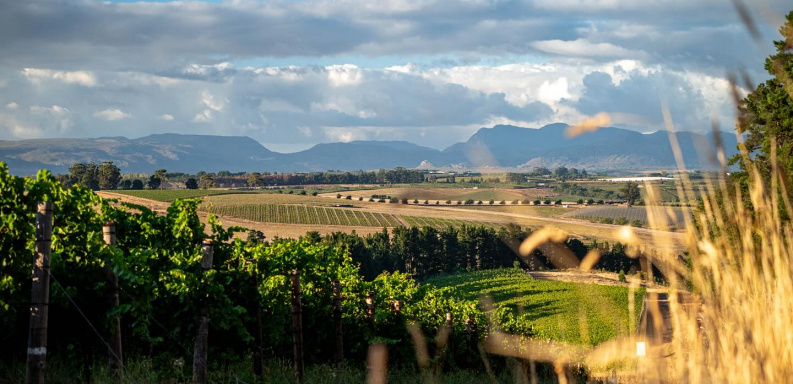Terroir talk: the Elgin Valley
By Malu Lambert | 3rd April 2024
70 kilometres east of Cape Town, the landscape changes dramatically over the boundary of Sir Lowry’s Pass. Into the heart of ancient sandstone Hottentots Holland mountains, the hills start to shade in greener. The abundant nature and veritable forests of fynbos are thanks to the surrounding Kogelberg Biosphere, a UNESCO World Heritage site. At the centre of this 3000-hectare nature reserve Elgin’s vineyards correspondingly adhere to sustainable practices; such as the Biodiversity Wine Initiative (BWI) scheme as well as the Integrated Production of Wine system (IPW). The 20 estates all have an overarching commitment to eco-friendly viticulture.

Elgin with its cool climate and an annual rainfall of between 800 and 1200 mm (which mainly falls in winter) has seen it being dubbed ‘little Burgundy’. Across its 721 hectares of vineyards it should come as no surprise then that chardonnay and pinot noir shine. Aromatic varieties fare well too, such as riesling and sauvignon blanc. While also on the black grape side syrah and merlot are making increasingly excellent renditions.
High-lying Elgin is said to have the coolest climate in South Africa. Enclosed by those mountains, slopes rise from 250 to 500 metres above sea level. The soils are a varied mix, with well-draining Bokkeveld Shale and Table Mountain Sandstone soils being the most dominant.
Elgin’s climate has another unique attribute, it’s a region with its head in the clouds. Wind – and the resulting clouds are an elemental force here, from the regular summer southeasterly sea breezes off the cold Atlantic to the black South Easter wind, which creates cloud cover leading up to and during harvest.
The mists and low clouds create filtered sunlight. This reduces canopy temperature, prolongs ripening, and enhances flavour complexity. This includes a complex combination of elements, such as Ultraviolet B radiation creating abscisic acid, which according to research conducted by *Wines of Elgin produces ‘subtler, more restrained fruit as well as tannin structure’.
Growers harness all of these natural attributes to produce elegant wines from their altitudinous, dryland farmed vineyards. Some of which now include contemporaries from traditionally warmer areas, among them famed estates, Tokara, Boschendal, Vrede en Lust and Thelema.
Historically an apple-growing area, viticulture is fairly new. The story begins in 1896 when the Clüver family began farming apples on the De Rust farm. Fast-forward to 1986, and generational scion Dr Paul Clüver planted Elgin’s first vines. The region was declared an official wine ward in 1990.
“What makes the region suitable for apples makes it even better for wine,” comments Andrew Gunn, proprietor of Iona Wine Estate, Elgin’s highest estate at 420 metres above-sea-level. The apples, like the grapes thrive in the cold winters followed by the long growing season the moderate summer conditions provide. “Elgin has a wide variety of soils, aspects and meso climates but the macro climate is generally considered to be cool to intermediate,” continues Gunn.
Further explaining the benefit of the climate Werner Muller, Iona’s winemaker says:
“The prevailing southeasterly winds during the growing and ripening season pushes cold air up over the vineyards, contributing to making it one of the coolest vineyard sites in the country. The grape cluster stays connected to the vine for longer, achieving physiological ripeness more gradually at lower temperatures. Acid degradation is slow and delicate aromatic compounds are retained at lower sugar levels and consequently lower alcohols.”
Elgin may have its head in the clouds, but its wines are straight from the earth; pure, terroir-driven and elegant.
*Image credits Wines of Elgin
